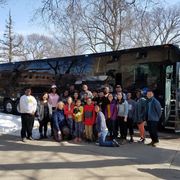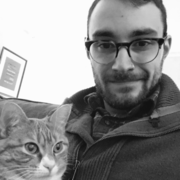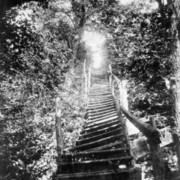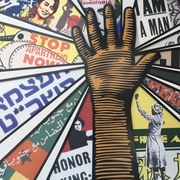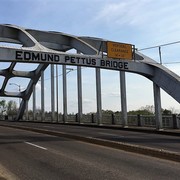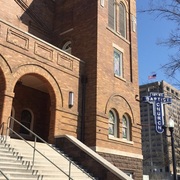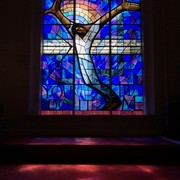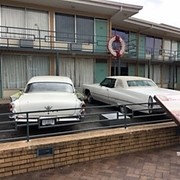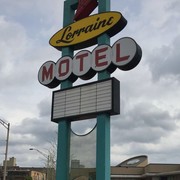Northfield to Selma
See a message from Dean of Students Carolyn Livingston about the Northfield to Selma trip.
-
Thursday, March 16 2017
It’s day 1 on our road trip from Northfield to Selma! Follow our series of student blog posts to get a taste of what us Carls have been up to as we journey across the South learning about African American history and its importance in American history.
Thursday, March 16: Day One
Friday, March 17, 2017Today, we traveled from Northfield, Minnesota to Indianapolis, Indiana. It took a little longer than planned, but the majority of us either slept, watched Netflix or talked with a friend. A few of us propped up a laptop and watched Lemonade, Beyoncé's visual album that came out last year. Since the one hour film discussed topics about police brutality and the role of black women in America, it was pretty fitting for our trip that surrounds African American history and culture.
Thursday, March 16: Day One
Friday, March 17, 2017Eager to depart for our trip we scrambled to the bus in a hurry. With bursting bags in hand and heavy coats on our backs, we set our luggage down and boarded the bus with hopes of leaving the cold Minnesota weather behind. Each one of us claimed our seat on the spacious bus and made sure we had everything we needed. Last minute trips to Sayles were a given but before we hit the road we gathered outside for a group photo. Once all loaded on the bus we hit the road and headed East of Northfield.
View all items in Thursday, March 16 2017. -
Friday, March 17, 2017
Day 2 brings us to Cincinnati, Ohio as we explore the National Underground Railroad Freedom Center.
Learning Strategies with Steve Schauz
Friday, March 9, 2018A one-on-one with Carleton's, Steve Schauz - Residential Life Area Director of Goodhue/Evans and Academic Skills Coach in the ASC...
Friday, March 2017: Day Two
Saturday, March 18, 2017Today we made our first stop on our trip to Selma at the National Underground Railroad Freedom Center (NURFC) in Cincinnati, Ohio. As one of the first post-American Revolution boomtowns, Cincinnati became the largest non-coastal town in the U.S. and a significant site of commerce and tourism. A lesser-known fact is the city’s prominent role in the fight for abolitionism. Historian Wilbur Siebert believes approximately three thousand miles of Underground Railroad trails existed in Ohio, with many beginning in and around Cincinnati. Residents worked together to provide refuge for freedman and fugitive slaves when there was no certainty that slavery would end. During our tour of NURFC we learned about the involvement of the Cincinnati area riverside village of Ripley which served as the most heavily-trafficked border crossing from Kentucky—a slave state. The partnership of two abolitionists in town was most captivating.
View all items in Friday, March 17, 2017. -
Saturday, March 18 2017
Moving on to Washington DC as we begin Day 3 of our road trip to Selma. We start with a tour the Frederick Douglass House – home to African American abolitionist and social reformer who hosted others such as Susan B Anthony and Harriet Tubman here. Next for the day is the National Museum of the American Indian followed by a choice of the Holocaust and Spy Museums. We wrap up the day at Ben’s Chili Bowl – a restaurant that has played a large role in fostering the black community in DC for decades and has kept its doors open throughout changing political climates dating back to the Civil Rights era. Oh, and not to brag, but we ate where President Obama ate along with some amazing Carleton alums!
Saturday, March 18: Day Three
Monday, March 20, 2017Today we visited 3 sites in the nation’s capital, Washington D.C. Before I discuss the places we went, I just want to talk about how amazing the city of D.C. is. I got my first bit of real warmth since winter break in Palo Alto, so I was already in a good mood. Secondly, being back on the east coast made me feel 10x more at home. I could definitely see myself living in D.C after Carleton. The location is great with it being a short drive to other great cities like Philadelphia, Baltimore, and New York, and it has some of the most important historical landmarks and sites. Lastly, it a city with diversity, which is at the top of my list of things I need in the place that I live.
Saturday, March 18: Day Three
Sunday, March 19, 2017We went to Frederick Douglass’ house, the National Museum of the American Indian (the Smithsonian), the International Spy Museum, and Ben’s Chili Bowl.
At Frederick Douglass’ house, I got a glimpse into the lives of abolitionists. I learned a lot about conductors of the Underground Railroad. In school, I was just told about Harriet Tubman helping slaves run from slave catchers and dogs to free states up North. I always imagined Harriet just following some train tracks to freedom. I realized there is so much more to it. A community of people, free blacks and whites called conductors, risked their lives to help free slaves by either harboring them in their homes or running alongside them to guide them to freedom.
View all items in Saturday, March 18 2017. -
Sunday, March 19 2017
Day 4 brings us to the new National Museum of African American History and Culture, hands down one of the best museums across the US. It was a moving depiction of the history of slavery and the contributions of the African American community to this country, both in the past and the present. We spend the rest of Day 4 touring the Mall, which includes Martin Luther King Jr., Franklin D Roosevelt, and Lincoln Memorials.
Sunday, March 19: Day Four
Monday, March 20, 2017On March the 19th, while on the Northfield to Selma trip, I had the pleasure of visiting the National African American History Museum, the Martin Luther King Memorial, The FDR Memorial, and the Lincoln Memorial. All the memorials were amazing; I was especially impressed withe National African American History Museum. The museum is not only my favorite part of the trip thus far but the best museum I have ever been to. I highly recommend visiting DC just to see the National African American History Museum.
I chose to write a poem about what I took away from my experiences:
Sunday, March 19: Day Four
Sunday, March 19, 2017Today was my favorite day on our trip so far. Our first stop was the National Museum of African American History and Culture. This is the only national museum solely devoted to African American history, culture, and life. The new Smithsonian opened this past September and has a total of 7 floors. Because of its magnitude, we were given a lot of time in the museum to explore and learn. Our second adventure for the day was a monuments tour on the National Mall. We got a personal tour from a park ranger and walked all around D.C.
View all items in Sunday, March 19 2017. -
Monday, March 20: Day Five
Tuesday, March 21, 2017Today was a longer travel day for us as we ventured out from Virginia to Atlanta, Georgia! At this point I think we've all found our prime sleeping positions and we're starting to get used to the lengthy bus rides (hopefully!). This bus time has also given me a chance to reflect on all the information we've grasped on this trip thus far.
Yesterday was a day that not only made me realize how many details I had forgotten about American History but also how much African American history I had not learned in school. The National Museum of African American History in particular was very memorable to me. When we first boarded the elevator to enter the exhibit, I remember one of the staff members saying that "Black History is American History". After walking through the dense history of the slave trade, segregation, and Civil War, I was most astounded by the sheer documentation and detail that came along with this museum. Centuries of oppression brought a greater push for equality and built solidarity, which I truly felt especially once I reached the top floors of the museum that displayed modern day African American culture. From music to television to food, I felt lucky to see the impact of history on ongoing traditions and culture.
Monday, March 20: Day Five
Tuesday, March 21, 2017The Erasure of Queer & Trans Black History
Walking through the National Museum of African American History and Culture was a transcendent experience. Each exhibit was curated with intention, revealing many of the intimacies and intricacies of Black life in the United States. In many ways, this is the museum that African Americans deserve; it gives us life amidst death, shows the resilience of our ancestors and imagines a future filled with Black creativity, solidarity and love. This said, I was disheartened by the all-too-familiar lack of Black queer and trans histories from the narrative being portrayed. As a space that is dedicated to understanding Blackness in all its forms, it was vexing to see that Black queer and trans folk were not given a seat at the table.
View all items in Monday, March 20 2017. -
Tuesday, March 21: Day Six
Wednesday, March 22, 2017Waking up as early as 6:00am, we boarded the bus and headed to the Martin Luther King National History Museum in Atlanta, Georgia. We arrived a little early, so we all slept on the bus until the museum opened. We were one of the first groups to enter the museum which was great. We explored a small section of the museum and watched two films, which seemed a little out dated. Afterwards, we went walked around the park where the memorials for King and his wife Coretta Scott King are located. Inside, we learned more about the two and Rosa Parks. We also went inside Ebenezer Baptist Church where a King sermon recording was heard throughout the church.
Tuesday, March 21: Day Six
Wednesday, March 22, 2017Welcome to Day Six! Time has flown by on this trip, from the limitless snacks to the insightful conversations with people from all walks of life as we progress from state to state. This morning, we drove through the beautiful streets of Atlanta, Georgia from our safely-located hotel to the Martin Luther King Jr. National Historic Site; there, we were able to visit MLK's boyhood home, the Ebenezer Baptist Church (where King was baptized and was a pastor), the visitor center chronicling the American Civil Rights Movement, and much more. Visiting these sites (and sights) allowed me to establish a more tangible and emotional connection beyond the research and readings of the classroom, drawing attention to the power and impact that MLK and Coretta Scott King had on the growth, the people, and the spirit of the movement.
View all items in Tuesday, March 21 2017. -
Wednesday, March 22: Day Seven
Thursday, March 23, 2017Today, we ventured across Alabama - one of the most segregated states in the antebellum south. This experience was particularly emotional because we had the opportunity to walk across the Edmund Pettus Bridge and participate in a simulation that was meant to bring to light the horrible conditions that slaves went through. We were led through these excursions by Civil Rights freedom fighter Sam Walker, a jovial yet stern old man, who shared history and memories from his time as a young 11 year old. I witnessed a conversation between Walker and some of the younger kids on our trip - he explained to them that he was not much older than they were when he was first sent to a jailhouse for participating in protests that were spread throughout the state in response to the murders of many young African Americans such as the Four Little Girls and Jimmy Lee Johnson. Watching the kids mouths drop in shock was moving - this man grew up during much harder times and fought for justice and equal rights so that these same kids could grow up in a more accepting time.
View all items in Wednesday, March 22 2017. -
Thursday, March 23: Day Eight
Friday, March 24, 2017Today, Thursday, March 23rd, we finally had one of the sunniest days during our wondrous trip in Birmingham, Alabama. It was finally refreshing to be greeted by the sun after a long and treacherous winter in Minnesota. As I woke up in the morning, I realized today was going to be an emotionally exhausting day like many on this trip. With this, allow me to take you on a journey through The Magic City.
As is usual, I was running late and had to quickly run down and get breakfast. The ride from our hotel to our first historical stop was breathtaking. The scenery was green and beautiful, with the sun creating shadows on trees and grass as we swiftly passed by. The bus abruptly stopped in front of a historical and well-known church of the Civil Rights Movement: the 16th Street Baptist Church. Here, we were going to learn about four little girls who died in a bombing inside the Church due to a group of white men’s deep rooted hate towards African-Americans.
Thursday, March 23: Day Eight
Friday, March 24, 2017Today was an emotionally heavy day as we centered our attention to the city of Birmingham, Alabama: the center of many important civil rights moments and the heart of vicious segregation back in the 1960s, so much so that it was nicknamed “Bombingham.” I close my eyes; it is difficult and eerie to think of how different the social landscape around us would have been not too long ago. The aged red brick buildings, calm green parks, and empty concrete streets rendered in full color (compared to the black and white images/video we have of the past), conjure a lot of dissonance and deep reflection.
View all items in Thursday, March 23 2017. -
Friday, March 24: Day Nine
Saturday, March 25, 2017Today, we woke up on the right side of the bed in Birmingham, AL. This was the first and only night we got to stay in the same hotel for a second time so the day was off to a leisurely start. We made our way to Memphis, Tennessee to visit the Lorraine Motel, the place where Martin Luther King was shot. When we arrived, I think it was, for all of us, a site with a significantly important aura. Connected to and intertwined with the Lorraine Motel, was the National Civil Rights Museum. Here we saw MLK's hotel room-preserved for the public, various facets of both the Slavery and Jim Crow era and the spot where the shooter was located when he shot MLK.
Friday, March 24: Day Nine
Saturday, March 25, 20176:30am we left Birmingham and traveled to Memphis, Tennessee. Today we were headed to visit the National Civil Rights Museum at the Lorraine Motel and The Stax Museum of American Soul— a bittersweet closing to our trip.
The National Civil Rights Museum at the Lorraine Motel solidified what we learned in our previous visitations on the history of oppression, pain, perseverance, and hate in American history. Civil rights and social change took hundreds of people organizing meetings, strategizing, training etc. The Bus Boycott is one of the better-known protests and I clearly remember learning about it in school. However, the museum brought to my attention that the Women’s Political Council had initiated the one-day boycott.
View all items in Friday, March 24 2017. -
Saturday, March 25: Day Ten
Tuesday, March 28, 20178:30 a.m. we departed from St. Louis, Missouri to embark on an 8-hour journey (not including breaks) back to Northfield, Minnesota. As we sat on the bus I was left to think about the events of the past nine days and its impact in my life. It is said that History repeats itself; through the lenses of this trip I witnessed history repeating itself.
View all items in Saturday, March 25 2017.
